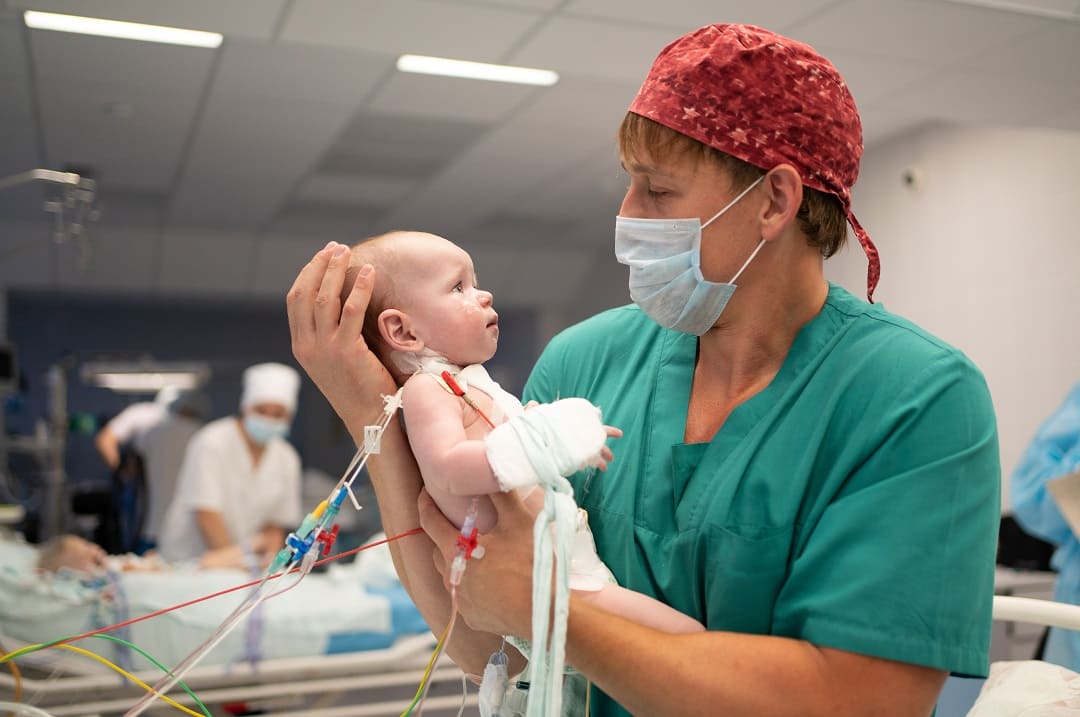
Congenital Heart Defects in Children: When a Small Heart Needs Big Help🆘 Wrodzone wady serca u dzieci: gdy małe serce potrzebuje wielkiej pomocy
A congenital heart defect is one of the most serious and common conditions in newborns. Every year, around 12,000–14,000 children in Russia are born with it. That means: one in every hundred babies enters the world with a heart that isn’t built right.
What is a congenital heart defect?
It’s a structural abnormality in the heart or major blood vessels that develops in the womb. Some children are born without the wall between heart chambers. Some have blood flowing through the wrong vessels. Some have a chamber that doesn't work. In the most severe cases, half of the heart is missing.
This is not a minor issue — it’s a life-threatening condition. If left untreated, the heart can’t properly circulate blood, oxygen doesn’t reach the body, and the child can die.
What causes it?
The exact causes are still not fully known, but risk factors include:
-
infections during pregnancy (e.g., rubella);
-
certain medications or alcohol use;
-
diabetes in the mother;
-
genetic mutations or syndromes;
-
environmental pollution, radiation, severe stress.
Sometimes it’s simply a random developmental error — no one is to blame, but the consequences are devastating.
How is it detected?
Some defects are seen during pregnancy via fetal heart ultrasound. Others are diagnosed after birth — when the baby shows signs like blue lips, trouble feeding, shortness of breath, or poor weight gain.
In some cases, the child looks healthy — until symptoms suddenly appear weeks or months later. Early diagnosis is critical. Every minute matters.
How is it treated?
Congenital heart defects do not go away on their own. No pill or diet can fix a structurally faulty heart. In most cases, surgery is needed — and often, several surgeries over time.
-
Mild defects might be treated using catheter-based interventions.
-
Severe defects require open-heart surgery, often with a heart-lung machine.
In some cases, a heart transplant is the only hope.
This treatment is medically complex — and financially overwhelming. Even when the surgery is covered, families often face high costs for travel, medications, and recovery.
What happens without treatment?
Children with severe heart defects die. Some in infancy. Others later — but their lives are marked by pain, exhaustion, and constant struggle. They grow up in hospitals, not playgrounds. Their childhood is filled with tubes, machines, and fear in their parents’ eyes.
The bottom line
A heart defect is not a death sentence — if caught and treated in time. Every one of these children can be helped. But it takes technology, doctors, money — and compassion.
They didn’t choose to be born with a broken heart. But we can choose: to look away — or to help it keep beating.
🇵🇱
Wrodzone wady serca u dzieci: gdy małe serce potrzebuje wielkiej pomocy
Wrodzona wada serca to jedna z najpoważniejszych i najczęstszych chorób u noworodków. Co roku w Rosji rodzi się z nią około 12–14 tysięcy dzieci. To oznacza, że jedno na sto dzieci przychodzi na świat z sercem, które od początku działa nieprawidłowo.
Co to jest wrodzona wada serca?
To nieprawidłowość w budowie serca lub dużych naczyń krwionośnych, która powstaje jeszcze w łonie matki. U niektórych dzieci brakuje przegrody między komorami. U innych krew płynie nieodpowiednimi naczyniami. Zdarza się też, że jedna z komór w ogóle nie działa. W najcięższych przypadkach brakuje połowy serca.
To nie jest „mały problem”. To zagrożenie życia. Bez leczenia serce nie może prawidłowo pompować krwi. Ciało nie otrzymuje tlenu. Dziecko umiera.
Co powoduje wadę serca?
Dokładne przyczyny nie są jeszcze całkowicie poznane, ale wiadomo, że wpływ mają:
-
infekcje u matki w ciąży (np. różyczka);
-
przyjmowanie niektórych leków lub alkoholu;
-
cukrzyca ciążowa;
-
wady genetyczne i zespoły;
-
zanieczyszczenie środowiska, promieniowanie, silny stres.
Czasami to po prostu przypadkowy błąd w rozwoju płodu. Nikt nie jest winny — ale skutki są dramatyczne.
Jak to się wykrywa?
Czasem wada zostaje wykryta jeszcze w ciąży — podczas USG serca płodu. Często jednak diagnozę stawia się dopiero po porodzie, gdy dziecko sinieje, ma trudności z oddychaniem, nie je i nie przybiera na wadze.
Zdarza się, że dziecko wygląda zdrowo — aż do momentu, gdy nagle stan się pogarsza. Wczesna diagnoza ma ogromne znaczenie. Liczy się każda minuta.
Jak się leczy?
Wady serca nie znikają same. Żadne leki czy dieta nie naprawią fizycznej wady. W większości przypadków potrzebna jest operacja — czasem kilka.
-
Lżejsze wady można leczyć małoinwazyjnie — przez cewnikowanie.
-
Poważniejsze wymagają operacji na otwartym sercu, z użyciem krążenia pozaustrojowego.
W najcięższych przypadkach jedynym ratunkiem jest przeszczep serca.
To wszystko wymaga nie tylko ogromnych umiejętności medycznych, ale też wielkich pieniędzy. Nawet jeśli operacja jest refundowana, rodziny muszą pokryć koszty leków, podróży, rehabilitacji. Nie każda rodzina daje radę.
Co się stanie bez leczenia?
Dzieci z ciężką wadą serca umierają. Niektóre zaraz po urodzeniu. Inne później — ale żyją w bólu, z dusznościami, w cieniu śmierci. Nie biegają, nie bawią się jak inne dzieci. Ich dzieciństwo to szpitale, rurki, operacje i strach w oczach rodziców.
Wniosek
Wrodzona wada serca to nie wyrok — jeśli zostanie wcześnie rozpoznana i leczona. Każdemu z tych dzieci można pomóc. Potrzeba jednak lekarzy, technologii, pieniędzy — i ludzkiego serca.
Te dzieci nie wybrały choroby. Ale my możemy wybrać, czy pomożemy im żyć.